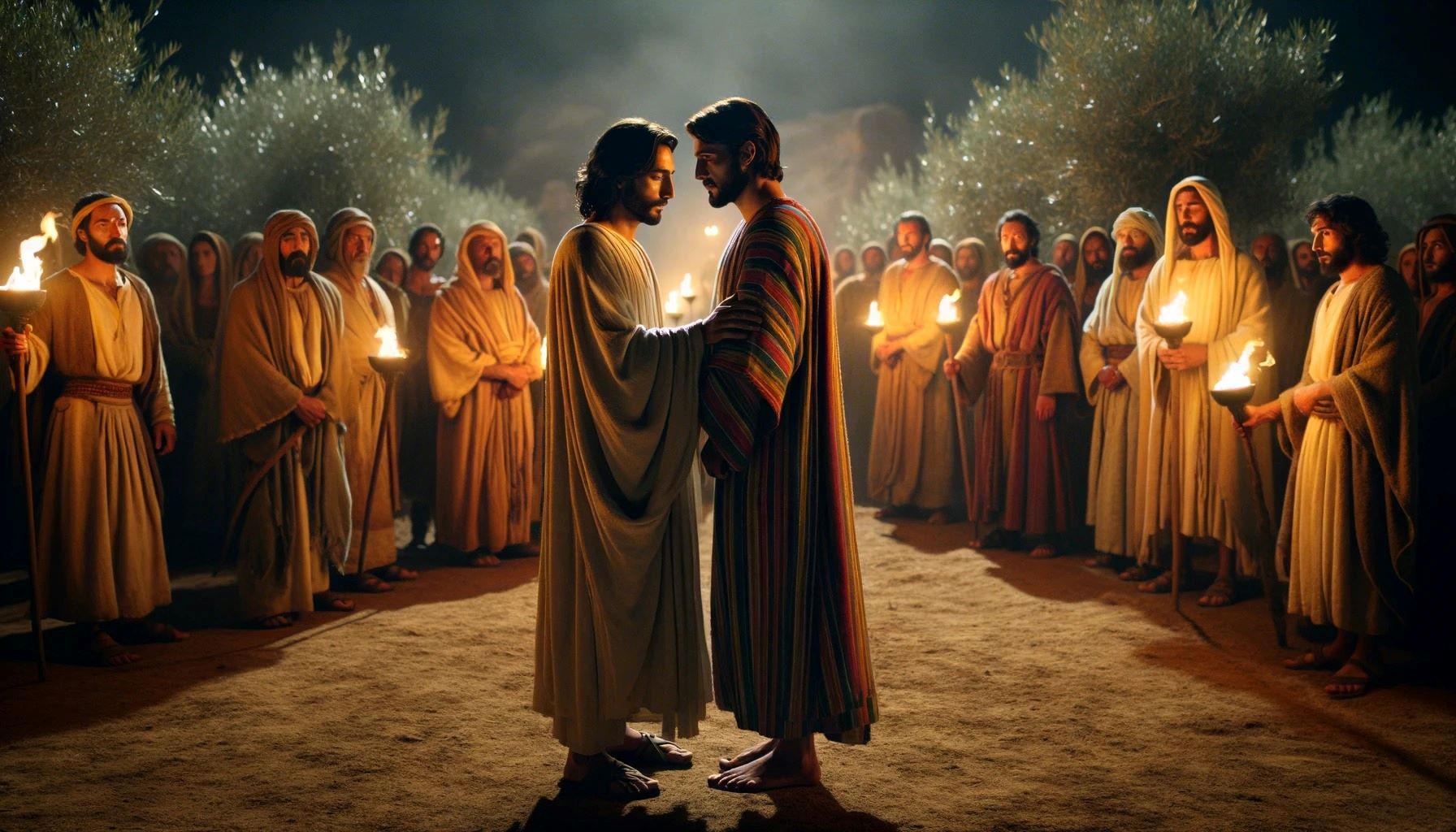Home>Christian Videos>Bible Stories>Who Is Jesus Christ In The Bible Verse?


Bible Stories
Who Is Jesus Christ In The Bible Verse?
Published: March 3, 2024
Ericka Andersen, an editor at Christian.net, expertly merges digital strategy with content creation, focusing on faith and societal issues. Her communication skills enhance the platform's engaging narratives, fostering meaningful dialogue on belief's impact on society.
Discover the significance of Jesus Christ in the Bible verse and explore the timeless teachings and stories in the Bible. Uncover the profound impact of Jesus in the Bible stories.
(Many of the links in this article redirect to a specific reviewed product. Your purchase of these products through affiliate links helps to generate commission for Christian.net, at no extra cost. Learn more)
Table of Contents
Introduction
Who is Jesus Christ in the Bible verse? Jesus Christ is a central figure in Christianity, revered as the Son of God and the savior of humanity. His life, teachings, death, and resurrection are foundational to the Christian faith. Understanding the role of Jesus Christ in the Bible verse is essential to comprehending the core beliefs of Christianity. In this article, we will explore the birth, teachings, miracles, death, and resurrection of Jesus Christ, as well as his significance in the salvation of humanity.
The Birth and Early Life of Jesus Christ
-
The Annunciation and Virgin Birth: The birth of Jesus Christ is a pivotal event in the Bible. According to the Gospel of Luke, the angel Gabriel visited Mary, a young virgin in Nazareth, and announced that she would conceive a child by the Holy Spirit. This miraculous conception is known as the Virgin Birth, fulfilling the prophecy of Isaiah 7:14. This divine intervention signifies the extraordinary nature of Jesus' birth and sets the stage for his extraordinary life and mission.
-
The Nativity and Bethlehem: The Gospel of Matthew and Luke narrate the story of Jesus' birth in Bethlehem. Mary and Joseph, who lived in Nazareth, traveled to Bethlehem for a census, as decreed by Caesar Augustus. Unable to find lodging, they took refuge in a stable, where Jesus was born. This humble beginning reflects the humility and simplicity that would characterize Jesus' life and ministry.
-
The Visit of the Magi and the Flight to Egypt: Following the birth of Jesus, wise men from the East, known as the Magi, came to Jerusalem, guided by a star, to pay homage to the newborn King of the Jews. King Herod, threatened by the news of a new king, sought to eliminate the perceived threat by ordering the massacre of all male children in Bethlehem. Warned in a dream, Joseph fled to Egypt with Mary and Jesus, fulfilling the prophecy, "Out of Egypt I called my son" (Hosea 11:1).
-
The Childhood and Early Years: The Bible provides limited information about Jesus' childhood and early life. However, the Gospel of Luke briefly mentions an incident when Jesus, at the age of twelve, engaged the teachers in the temple, astonishing them with his understanding and answers. This episode offers a glimpse of Jesus' wisdom and spiritual insight even at a young age.
-
The Family of Jesus: Jesus grew up in a humble family environment, with Joseph working as a carpenter. He had siblings, including James, Joses, Judas, and Simon, as mentioned in the Gospels of Matthew and Mark. Despite his ordinary upbringing, Jesus' life was destined for an extraordinary purpose, as he would later embark on a ministry that would profoundly impact the world.
Understanding the birth and early life of Jesus Christ provides insight into the miraculous circumstances surrounding his arrival, his humble beginnings, and the divine purpose that awaited him. These foundational events set the stage for the teachings, miracles, and ultimately, the redemptive mission of Jesus Christ.
The Teachings and Miracles of Jesus Christ
-
The Sermon on the Mount: One of the most renowned teachings of Jesus is the Sermon on the Mount, found in the Gospel of Matthew. This sermon encompasses the Beatitudes, which outline the characteristics of those blessed by God, as well as teachings on love, forgiveness, and the principles of the Kingdom of God. It is a profound exposition of ethical and moral principles that continue to inspire and guide Christians today.
-
Parables and Teachings: Jesus often used parables, or simple stories, to convey profound spiritual truths. The Parable of the Good Samaritan, the Parable of the Prodigal Son, and the Parable of the Sower are just a few examples of the impactful stories that Jesus used to illustrate timeless lessons about compassion, forgiveness, and the nature of God's kingdom.
-
Miracles: Jesus performed numerous miracles throughout his ministry, demonstrating his divine authority and compassion. These miracles included healing the sick, restoring sight to the blind, casting out demons, and even raising the dead. Each miracle served as a sign of God's power and love, offering hope and restoration to those in need.
-
Teachings on Love and Compassion: Jesus emphasized the importance of love and compassion in his teachings. His command to "love your neighbor as yourself" and his example of showing mercy and kindness to the marginalized and oppressed exemplify the central role of love in his message. Jesus' teachings on love and compassion continue to be a guiding light for Christians in their interactions with others.
-
The Lord's Prayer: When Jesus' disciples asked him to teach them how to pray, he shared the Lord's Prayer, a model prayer that encompasses adoration, submission to God's will, provision, forgiveness, and deliverance from evil. This prayer serves as a foundational template for Christian prayer and reflects Jesus' teachings on the nature of prayer and communion with God.
-
The Great Commission: Before ascending to heaven, Jesus charged his disciples with the Great Commission, instructing them to go and make disciples of all nations, baptizing them and teaching them to obey everything he had commanded. This commission serves as a call to spread the teachings of Jesus and share the message of salvation with the world.
The teachings and miracles of Jesus Christ are integral to understanding his message and mission. Through his profound teachings, compassionate actions, and miraculous demonstrations of divine power, Jesus revealed the nature of God's kingdom and the path to reconciliation, redemption, and eternal life.
The Death and Resurrection of Jesus Christ
-
The Crucifixion: The crucifixion of Jesus Christ is a central event in Christian theology. According to the Gospels, Jesus was betrayed by one of his disciples, Judas Iscariot, and subsequently arrested by the religious authorities. He was then tried, condemned to death, and crucified by the Roman authorities. The crucifixion, depicted in the Gospels of Matthew, Mark, Luke, and John, is a profound symbol of Jesus' sacrificial death for the atonement of humanity's sins. The significance of the crucifixion lies in its fulfillment of Old Testament prophecies and its role in the redemption and reconciliation of humanity with God.
-
The Resurrection: The resurrection of Jesus Christ is the cornerstone of the Christian faith. According to the Gospels, Jesus rose from the dead on the third day after his crucifixion, demonstrating his victory over sin and death. The resurrection is a testament to the divinity of Jesus and the fulfillment of his promise to conquer death. It is a source of hope and assurance for Christians, affirming the promise of eternal life and the power of God to overcome all obstacles. The resurrection of Jesus Christ is celebrated as the pinnacle of God's redemptive plan for humanity and the assurance of salvation for those who believe in him.
-
The Empty Tomb: The discovery of the empty tomb by the women who went to anoint Jesus' body is a pivotal moment in the resurrection account. The absence of Jesus' body from the tomb, accompanied by the appearance of angels who proclaimed his resurrection, signifies the miraculous nature of this event. The empty tomb serves as tangible evidence of Jesus' triumph over death and the beginning of a new era of hope and transformation for humanity.
-
Post-Resurrection Appearances: Following his resurrection, Jesus appeared to his disciples and numerous individuals, providing irrefutable evidence of his victory over death. These post-resurrection appearances affirmed the reality of Jesus' resurrection and solidified the faith of his followers. The encounters with the risen Christ brought comfort, reassurance, and a renewed sense of purpose to those who had witnessed his crucifixion.
-
The Ascension: Forty days after his resurrection, Jesus ascended into heaven in the presence of his disciples, marking the culmination of his earthly ministry. The ascension signifies Jesus' exaltation and reign at the right hand of God, where he intercedes on behalf of believers. It also foreshadows his eventual return, as promised in the New Testament, to establish God's kingdom in its fullness.
The death and resurrection of Jesus Christ are foundational to the Christian faith, representing the ultimate expression of God's love, grace, and redemptive power. These events form the basis of Christian hope, providing assurance of forgiveness, reconciliation with God, and the promise of eternal life for all who believe in Jesus Christ.
The Role of Jesus Christ in Salvation
The role of Jesus Christ in salvation is central to the Christian faith, as it encompasses the redemptive work and divine purpose of Jesus in reconciling humanity with God. The concept of salvation, rooted in the New Testament, emphasizes the deliverance from sin, spiritual restoration, and the assurance of eternal life through faith in Jesus Christ. The following aspects highlight the profound role of Jesus Christ in the salvation of humanity:
Read more: Who Buried Jesus Christ In The Bible
Atonement and Redemption
The death of Jesus Christ on the cross serves as the ultimate atonement for the sins of humanity. According to Christian belief, Jesus, as the sacrificial Lamb of God, offered himself as a perfect and unblemished sacrifice to reconcile humanity with God. His death provides redemption, forgiveness, and liberation from the bondage of sin, fulfilling the Old Testament foreshadowing of atonement through sacrificial offerings.
Justification by Faith
The apostle Paul expounds on the concept of justification by faith in his letters, emphasizing that through faith in Jesus Christ, individuals are declared righteous before God. This justification is not based on human merit or deeds but is a result of God's grace and the atoning work of Jesus. The role of Jesus Christ in justification underscores the transformative power of faith and the immeasurable value of God's redemptive love.
New Life and Rebirth
The teachings of Jesus and the apostles emphasize the notion of spiritual rebirth and newness of life through union with Christ. The apostle Paul describes believers as being "in Christ," signifying a profound spiritual union that brings about a new identity and a transformed existence. The role of Jesus Christ in salvation extends beyond forgiveness to the restoration and renewal of individuals, empowering them to live in accordance with God's will and purpose.
Mediator and High Priest
Jesus Christ serves as the mediator between God and humanity, bridging the gap caused by sin and offering access to God's presence. The book of Hebrews portrays Jesus as the ultimate High Priest who intercedes on behalf of believers, empathizing with their weaknesses and offering grace and mercy. His role as the mediator underscores the relational aspect of salvation, as believers are invited into a restored relationship with God through the redemptive work of Jesus Christ.
Read more: Who Is Jesus Christ’s Mother
Eternal Life and Hope
The role of Jesus Christ in salvation culminates in the promise of eternal life and the hope of the resurrection. The New Testament affirms that through belief in Jesus, individuals receive the gift of eternal life, transcending the temporal constraints of mortality. The resurrection of Jesus serves as a guarantee of the future resurrection of believers, offering hope in the face of mortality and assurance of a glorious future in the presence of God.
The role of Jesus Christ in salvation encompasses the multifaceted dimensions of atonement, justification, spiritual renewal, mediation, and the promise of eternal life. His redemptive work stands as the cornerstone of Christian faith, offering a pathway to reconciliation, transformation, and the assurance of God's unending love for humanity.
Conclusion
In conclusion, the life, teachings, death, and resurrection of Jesus Christ as depicted in the Bible verse hold profound significance in the Christian faith. From the miraculous circumstances of his birth to the transformative impact of his ministry, Jesus Christ embodies the embodiment of God's love, grace, and redemptive purpose for humanity. His teachings, parables, and miracles continue to inspire and guide believers, offering timeless wisdom and ethical principles. The crucifixion and resurrection of Jesus stand as the pinnacle of God's redemptive plan, providing assurance of forgiveness, reconciliation, and the promise of eternal life for those who believe in him. The role of Jesus Christ in salvation encompasses atonement, justification, spiritual renewal, mediation, and the hope of eternal life, underscoring the depth of God's love and the transformative power of faith. Ultimately, the Bible verse portrays Jesus Christ as the embodiment of God's love and the ultimate expression of hope, redemption, and eternal life for all who embrace his message.













